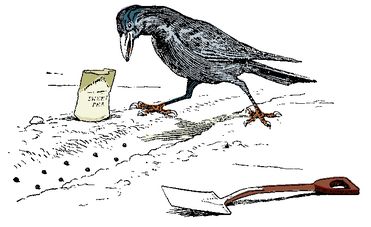Crows
Authors: Candace Savage


Table of Contents
ENCOUNTERS WITH THE WISE GUYS
OF THE AVIAN WORLD
OF THE AVIAN WORLD



{ PREFACE }
The Crow
CONNECTION
CONNECTION

 L
LIKE MOST PEOPLE, I have crow stories to tell. There was the time in the northern forest when a raven—and what is a raven except a crow taken to the extreme?—flew over my head, looked down, uttered a rasping call, and then made two complete barrel rolls before continuing smoothly on. “I am a raven,” it seemed to say, “and you, poor thing, are not.” There was the American crow, glimpsed through a car window just outside the city where I live, that was hanging by its beak from a branch and whipping around in the wind. More than anything, there is the everyday pleasure of seeing those lithe, calling forms rowing through the air, bound for somewhere. Any day with a crow in it is full of promise.
Admittedly, not everyone shares this enthusiasm for wild black wings. To some folks, crows and their kin—the ravens, jackdaws, and rooks—are nothing but a darned nuisance. Where a more sympathetic observer might appreciate the birds’ role as scavengers (nature’s clean-up crew), these people are disgusted by a diet that includes the dead and the rotten. Where you or I might hear an interesting confusion of crow voices, these others hear only noise. And where a thoughtful person might reflect on the intricate relationship between predator and prey, the crows’ detractors are alarmed by their depredations on songbirds. In this connection, it is worth noting that although crows do feed on eggs and nestlings, there is no evidence that these losses have reduced songbird numbers. Alas, the same cannot be said for the endangered desert tortoise of the southwestern United States, which is being battered by a burgeoning population of garbage-fed ravens.
Happily, for every person who views crows with distrust, there is someone who enjoys and appreciates them. One of the many delights of writing this book has been making contact with this growing flock of corvid enthusiasts. Who knew that there was a lively online community of crow people in various parts of the world, all busily tap-tap-tapping out their stories and sharing them with one another? Did you hear about the raven that dropped a crumpled-up bag on a kid who was holding an order of fries? Or how about the crows that, day after day, singled out a particular factory worker on his lunch break in a parking lot and treated him to intense displays of bowing and rattlelike calls? All this and much more is just a mouse-click away at sites like those listed on page 107.
➣
Birds of a feather flock together in this engraving of four crows and one crow cousin. In the midground, from left to right, are the jackdaw, rook, and carrion crow and the related black-billed magpie. In front, a common raven picks at a dead rabbit.
Birds of a feather flock together in this engraving of four crows and one crow cousin. In the midground, from left to right, are the jackdaw, rook, and carrion crow and the related black-billed magpie. In front, a common raven picks at a dead rabbit.

But this book is not just a celebration of day-to-day encounters with these fascinating birds. My aim is to delve deeper. The information in these pages derives primarily from a decade and more of systematic and often audacious research by leading scientists in three major regions: Europe, North America, and Australasia. It has been my privilege to speak with many of these experts and to hear firsthand about their discoveries, some of which have not previously been published. In particular, it is an honor to acknowledge the assistance of Vittorio Baglione, University of Seville, Spain; Thomas Bugnyar, Konrad Lorenz Research Station, University of Vienna, Austria; Anne Clark, University of Binghamton, USA; Nicky Clayton, Cambridge University, England; Peter Enggist, Enggist Science Consulting, Switzerland; Sylvia Hope, California Academy of Sciences, USA; Gavin Hunt, University of Auckland, New Zealand; Alex Kacelnik, Oxford University, England; John Marzluff, University of Washington, USA; Kevin McGowan, Cornell Laboratory of Ornithology, USA; Cynthia Sims Parr, University of Maryland Institute for Advanced Computer Studies, USA; and Daniel Stahler, Yellowstone Center for Resources, Yellowstone National Park, USA. Bernd Heinrich of the University of Vermont was interviewed for an article entitled “Reasoning Ravens” that was published in
Canadian Geographic
in 2000. John Spirko of Fort Erie, Ontario, and Sandy Harbanuk of the Juneau Raptor Center are among those who shared their stories with me; Barbara Hodgson provided the fine illustration that appears on page 17. A special word of thanks is due to Dr. Carolee Caffrey, until recently the West Nile virus specialist for the National Audubon Society, USA, for her enthusiasm, knowledge, and generosity.
Canadian Geographic
in 2000. John Spirko of Fort Erie, Ontario, and Sandy Harbanuk of the Juneau Raptor Center are among those who shared their stories with me; Barbara Hodgson provided the fine illustration that appears on page 17. A special word of thanks is due to Dr. Carolee Caffrey, until recently the West Nile virus specialist for the National Audubon Society, USA, for her enthusiasm, knowledge, and generosity.

 Crows are generalists, with a keen interest in all things edible. This engraving, by R. Havell, is based on a drawing by John J. Audubon.
Crows are generalists, with a keen interest in all things edible. This engraving, by R. Havell, is based on a drawing by John J. Audubon.Other books
A Question of Murder by Jessica Fletcher
Candy by K.M. Liss
The Corpse's Tale (Trevor Joseph Detective series) by John, Katherine
Net of Lies by Wolf, Ellen
Sapphire: A Werewolf Love Story by Dawson, Devyn
Descendant by Lesley Livingston
The Last Holiday Concert by Andrew Clements
The Seventh Sister, A Paranormal Romance by Z L Arkadie
Donutheart by Sue Stauffacher
